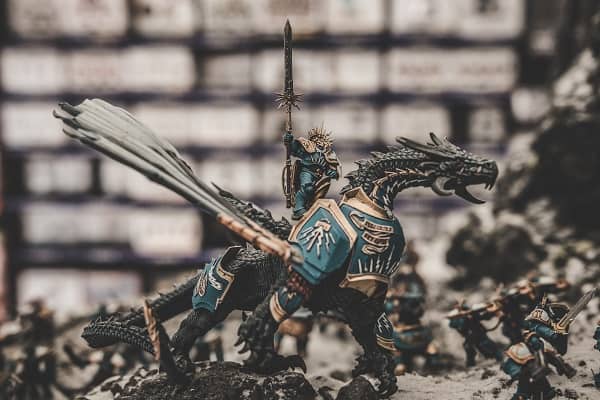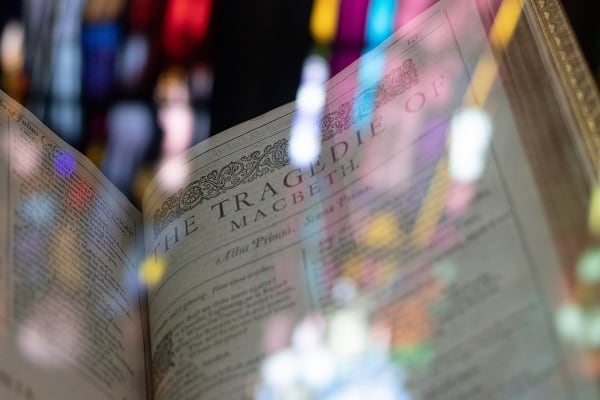While writers the world over struggle to craft truly original stories, theorists spend their time identifying ways in which they are actually all the same.
Joseph Campbell famously reduced the number of stories to just one: The Hero’s Journey, as outlined in his influential 1949 work, The Hero with a Thousand Faces.
In more recent times, other literary critics have theorised universal story archetypes ranging from as few as one to as many as 36. The most accepted number, however, appears to be seven, as proffered by Christopher Booker’s 2004 work, The Seven Basic Plots: Why We Tell Stories.
Readers and writers of the fantasy genre are no doubt familiar with the ‘Quest’ archetype. This storytelling pattern is best defined by Tolkien’s Lord of the Rings trilogy, which has long been an inspiration for many successful fantasy writers.
But the Quest, however captivating, is not the be-all and end-all of the fantasy storytelling.
If you want to branch out into something different but aren’t sure where to start, read on as we break down Booker’s six remaining archetypes and how they can work for you.
Plot #1: Overcoming the Monster
This plot archetype is exactly what it sounds like: a hero battles the forces of evil that threaten to destroy their current way of life.
Overcoming the Monster is a popular plot structure for many fantasy and science fiction stories. It can be observed in a great range of fiction – from ancient epics like Beowulf and Gilgamesh, to classic tales such as Dracula and War of the Worlds, and even more recently in hits like V.E. Schwab’s A Darker Shade of Magic and Naomi Novik’s Uprooted.
Part of the appeal of this archetype lies with the page-turning tension generated by the existence of a powerful, malicious force that comes up against a seemingly small and insignificant protagonist.
A struggle is inevitable, and the hero seems likely to fail – and maybe even does at some point along the way.
Booker identifies five stages to the basic ‘hero vs. monster’ plot:
- Anticipation: the hero’s call to action and establishment of a tyrannical force
- Dream: the first encounter with the monster or its underlings; the hero achieves significant success
- Frustration: failure to beat the monster itself
- Nightmare: appears likely the monster will triumph; becomes apparent the hero will meet his/her demise
- Miracle: the monster is defeated through the skill and courage of the hero; the world is liberated from evil

While the Quest can feature a voyage to defeat a greater evil, stories adhering to the Overcoming the Monster archetype tend to hit closer to home, with the final showdown occurring nearby the hero’s place of residence.
The proximity to the familiar helps keep the stakes high and the drama immediate for protagonist and reader alike – especially if ‘home’ has been well-established and made endearing to the audience.
Readers are drawn to these types of stories because of their overarching message of strength in adversity.
Tales of Overcoming the Monster are positive and hopeful and ultimately have happy endings. While the Quest may see the hero return to desolation (think the Scouring of the Shire in LotR), they triumph in Monster stories – and gain greater renown and power in the process.
Want to add a twist? Perhaps your monster isn’t a beast but a more abstract embodiment of evil. Is your hero battling addiction or personal demons? Is there a corrupt justice system punishing the wrong people, or an archaic power structure that needs to be overthrown?
The monster doesn’t need to be a person or a creature – it can be anything that threatens the peace of home.
Plot #2: Rags to Riches
Rising from the bottom of society to the top is a classic fairy tale trope. Beloved classic stories such as Cinderella, Aladdin and Puss in Boots are all timeless retellings that have been Disney-fied for modern audiences.
But Rags to Riches is not just found in folklore written for children: Jane Eyre is one of the most successful versions of this archetype, and young adult fantasy author Victoria Aveyard has created a hit with this pattern in her bestselling Red Queen series.
Like other archetypes, Rags to Riches can be broken down into a distinct pattern:
- The Call: establishment of the protagonist’s downtrodden position; introduction of the ‘call’ that propels them out of this situation
- Initial Success: the hero experiences trials and some small success in their new environment/position
- Central Crisis: everything goes wrong; previous oppressors return; the hero is separated from what they love; overwhelming despair
- Independence: the hero makes it through the crisis having discovered new strength; showdown with the obstacle between them and their goal
- Fulfillment: hero achieves all they ever wanted; suggestion that peace will continue indefinitely

Rags to Riches tales are relatable in that they aren’t solely defined as stories of the financially poor suddenly striking it rich. ‘Rags’ can represent any position of disadvantage and the ‘riches’ the protagonist obtains are the result of their success.
These types of stories are motivating to readers, often inspiring them to work hard and achieve their dreams, because – as the story reminds us – it can all work out in the end.
Given its prevalence in children’s fairy tales, the Rags to Riches plot tend to be typified by success and, as such, generally ends with a happily ever after. But that doesn’t mean you can’t turn the archetype on its head and go down the Power Corrupts path.
If you’re a writer of dark fantasy, subverting the expectation of a happy ending can be a great way to have fun with the genre and add a little plot twist towards the end. Just make sure you foreshadow and don’t leave yourself open to cheap shock tactics.
Plot #3: Voyage and Return
Voyage and Return might sound like just another way to describe the Quest, but the two are distinguished by how they address the return phase of the journey.
Using LotR as our Quest template again, the purpose of Frodo’s mission was to take the ring to Mordor and destroy it – not to make it back to the Shire.
‘Portal Fantasy’ stories such as The Wonderful Wizard of Oz, The Chronicles of Narnia and Alice’s Adventures in Wonderland are all examples of the Voyage and Return archetype, as they depict ordinary real-world characters being transported to strange and magical lands, from which they inevitably need to find their way back.
Because the original setting is often dull and dreary, the sudden teleportation to a weird and wonderful new world promises the reader an exciting adventure alongside the hero.
In the Voyage and Return story, five stages are likely to occur:
- The Fall: the hero ‘falls’ into the new world through chance or accident, leaving their mundane reality behind
- The Dream: while strange and perplexing, the new world is magical and exciting
- The Frustration: curiosity turns to discomfort and the adventure takes a dark turn through an oppressive force or evil magic
- The Nightmare: the hero is now in danger; both their life and/or ability to return home are threatened
- The Escape: the hero pulls off a miraculous escape and returns to their life having learned or gained something significant

Unlike Overcoming the Monster, which shares almost identical plot points, there is plenty of potential for the Voyage and Return story to not have a happy ending.
If your protagonist left for a strange and distant land in search of a cure for an illness reaping havoc on their village, their return might just be too late. Or perhaps they struck up a new romance in the distant land and returning home means leaving their soulmate behind?
These types of stories are particularly loved by young readers because of the magical escape from reality they offer. However, if real world cross-over fantasies aren’t your thing, your voyage can also take place entirely in a fantasy setting.
As long as the hero departs their norm for something strange and different before returning with something new, the archetype stills works.
Plot #4: Comedy
Comedy is not something one generally associates with fantasy fiction, which predominately focuses on high-stakes, end-of-the-world scenarios. But the Comedy archetype hails back to the Shakespearean model and not the slapstick, joke-cracking genre we’re familiar with today.
Comedy stories focus on the absurd and the ironic, often featuring cases of mistaken identity and things going wrong in the most ridiculous of ways.
Terry Pratchett‘s Discworld series is a hugely successful example of the fantasy genre with a comedic twist; his co-authored work with Neil Gaiman, Good Omens, is equally masterful; and William Goldman’s The Princess Bride is considered by some as one of the ‘funniest, most romantic, most swashbuckling fantasy novels ever written‘.
So what is the Comedy formula?
Unlike the other archetypes, which contain five distinct stages, Booker only identifies three elements that define Comedy:
- The Shroud of Confusion: the situation is established as one of confusion and uncertainty; characters are likely frustrated and somehow isolated
- The Darkening Shadow: the confusion or misunderstanding descends into chaos; an evil figure may try to use this to their advantage
- Joyful Enlightenment: the truth comes to light in a miraculous manner; misunderstandings are realised and joy prevails

The comedic storyline does not need to be ha-ha-funny; likewise, not all funny stories adhere to the Comedy formula. A bit of comic relief can be useful in many fantasy novels to avoid overwhelming the reader with too much darkness.
Does your assassin protagonist accidentally bump off the wrong person? Are they forced into a disastrous charade to avoid their mistake coming to light?
The key to Comedy – both Booker’s and Shakespeare’s – is that everything works out in the end, however contrived it may seem. Misunderstandings will be untangled and even the most absurd bungles are happily resolved.
If you’re struggling to gain traction with your current narrative, perhaps an absurdist twist can help give it new life.
Plot #5: Tragedy
Many define tragic stories as those which feature a figure or location affected by a traumatic, devastating event, such as natural disaster or the personal loss of a loved one. In addition, they tend to be typified by unhappy endings.
While this does remain true of the Tragedy archetype, this particular story pattern is actually defined by a specific motif: a hero destroyed by a fatal flaw.
This format harks back to Shakespearean times and some of the best examples of the style are among his most famous works. The central characters of Hamlet, Macbeth and Othello are all undone by their flaws (indecisiveness, ambition and jealousy respectively), while the star-crossed titular lovers of Romeo and Juliet are also the creators of their own demise.
In more contemporary literature, the novels Requiem for a Dream, The Picture of Dorian Gray and Madame Bovary also feature characters whose tragic circumstances are the result of their own decisions or personal shortcomings.
The formula for a traditional Tragedy outlines the downfall of the hero:
- Incomplete Needs: the hero wants to obtain what is lacking
- Temptation: means to achieve what is desired appears before the hero; the hero pursues it despite warnings, often encouraged by an antagonist
- The Slippery Slope: frustration builds as things begin to go wrong for the hero
- Loss of Control: downward spiral to disaster and despair
- The Destruction of the Hero: consequences of the hero’s action come to the fore; redemption is not possible; death is common

While not every story that has a sad ending is classified as a Tragedy, all Tragedies do have sad endings.
When applying the Tragedy archetype to the fantasy genre, it’s essential that the protagonist’s undoing is related to a flaw in their character.
Does your overly-ambitious hero seek to revolutionise a corrupt world with little regard for who gets squashed in the process? Are they so set on gaining power to topple the forces of evil that they sacrifice their soul for power, only to become the villain they sought to destroy?
Fatal flaws are a great trope to explore in fantasy novels and can work within a number of the known archetypes. But remember, to be a true Tragedy, your protagonist must be beyond redemption at novel’s end. Otherwise it’s just unhappy.
Plot #6: Rebirth
The last of Booker’s identified plot patterns is Rebirth, which is essentially Tragedy in reverse.
This archetype works specifically with the character arc and goes beyond a journey of redemption; the character in question must undergo enlightenment, which transforms the essence of their being.
Popular among children’s tales, this format is found in Dr Seuss’ How the Grinch Stole Christmas, Dickens’ A Christmas Carol and the original French fairy tale, The Beauty and the Beast. Fans of the ever-popular Harry Potter series also regard Snape’s character arc going beyond that of a redemption story, fitting more as a tale of Rebirth.
A Rebirth story generally features the following phases:
- Initial Darkness: the character is in a state of darkness, be it through magic spell, misfortune or tragic event
- Status Quo: the character becomes content with their ‘evilness’
- Returning Shadow: the character is reminded of the reason behind their situation
- Continued Agony: the character is resigned to their fate; sees no hope or reason to change
- Redemption: the character faces a choice between light and dark; inevitably chooses light, thus changing their ways

A character’s step towards Rebirth is usually facilitated by another character, such as Beauty in Beauty and the Beast and the spirits in A Christmas Carol.
Because the Rebirth story works specifically with the character arc, this archetype has the potential to overlap with other formulas.
Perhaps the hero is actually evil at the beginning of the story and, through the stages of Rebirth, gains enlightenment after setting out on a mission of Voyage and Return? If magic is at play in your world, the hero may seek to save the cursed Monster rather than battle to overcome it – something encountered numerous times in Andrzej Sapkowski’s The Witcher series.
In fantasy fiction, use of the Rebirth model can help establish sympathy for the villain, which is a great alternative in a genre that is often very black-and-white in moral dichotomy.
***
No matter how hard you’ve laboured to craft an original plot for your fantasy novel, chances are it still adheres to one of the formulas identified by Booker’s Seven Basic Plots – and that’s not a bad thing.
Formulas work, which is why they are replicated time and time again.
But with a great deal of fantasy novels featuring a band of unlikely heroes embarking on The Quest for glory, it’s little wonder some writers seek a point of difference by exploring other archetypes.
Character-centric plots can be bolstered with a tragic hero or enlightened villain; tired old tales are refreshed with a blend of irony and nonsense. Don’t be afraid to focus on an internal journey rather than a physical voyage.
Which is your favourite of Booker’s Plots? Are there any stories that break these archetypes, or any plot types not identified?
We’d love to hear your thoughts in the comments below!